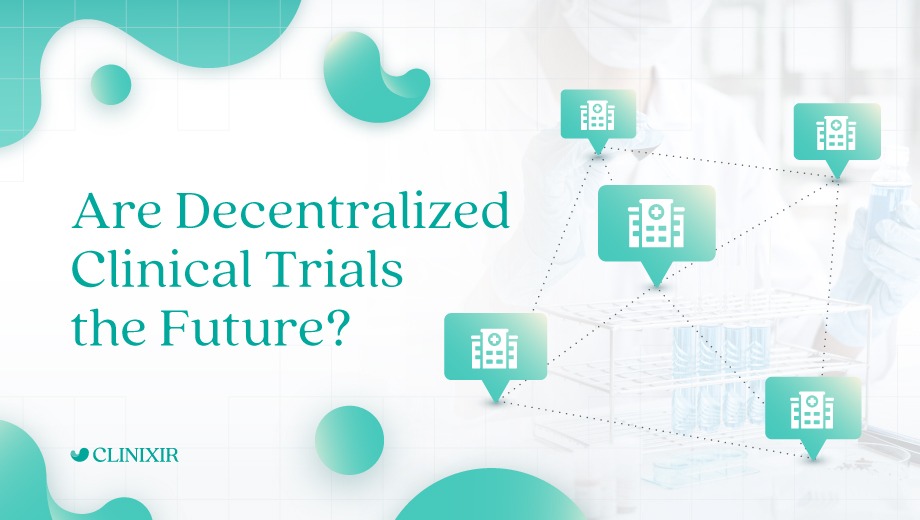Prior to Covid, Decentralized Clinical Trials (DCT) were rare and difficult to manage, often restricted to small samples for pilot projects with limited reach. The ongoing pandemic has served as a catalyst for DCTs, however, despite a sharp learning curve as well as significant barriers to entry.
The easing of restrictions has made traditional clinical trials, often conducted in hospitals and universities, feasible again. Yet DCTs, once outliers, have since proven their worth – and there is good reason to believe they are here to stay. The recent surge in DCTs is an important phenomenon in the evolution of clinical research, and it is worth exploring their pros and cons.
Pros:
Improved patient experience
DCTs are better suited to adapting and addressing patient needs than traditional clinical trials. They accelerate clinical development by placing less of a burden on patients, and may also generate a stronger evidence package than traditional trials.
Decentralizing the locations where trials can be conducted broadens the patient pool and makes participation easier for people who have a fear of hospitals, as well as for the economically disadvantaged and people from the disabled community. In many cases, these vulnerable groups have been hard to reach, and for that reason are often neglected in more traditional clinical trials.
Lower barriers to recruitment
Once limited in reach, digital healthcare, telemedicine and online pharmacies are becoming ubiquitous as a result of shifts prompted by the pandemic. This trend is likely to accelerate, as health providers compete in the digital realm to provide customers with more convenient services. For many patients, visiting central locations to participate presented a significant barrier to entry, often leading to incomplete studies and low retention rates.
Even prior to Covid, many vulnerable clinical groups were hesitant to participate in on-site trials, making it difficult to recruit these types of participants for the duration of studies. One of the key benefits to DCTs is the ease with which patients can be recruited through the use of smartphones, wearable technology, and computers.
Higher patient retention rate
These widely available tools place a much lower burden on participating, reporting, and engaging with researchers through the use of apps and programs that are user-friendly and easily available to a broad spectrum of the population, leading to more robust statistical samples of a given population or sub-group with less ongoing monitoring required by researchers.
A hybrid approach means that trials can be either standard or siteless. By arranging an initial orientation session for guidance on the app/technology, researchers can make patients more comfortable throughout the study and therefore more likely to participate for the duration. Technological advances can likewise make it easier for patients to ask questions or receive clarification during the trial, which also improves data quality as well as retention rates.
Optimized efficiency for trials
Advances in wearable technology, standardized apps, and simplified reporting tools enhance efficiency while reducing the reporting burden on participants. Of critical importance and often overlooked is the ability of the data generated by DCTs to be used in multiple studies or cross-referenced data sets. Metadata collected by one DCT can be used for multiple trials, and the ability to store significant medical histories obtained during individual trials can dramatically improve the accuracy of other future studies.
Cons:
As R&D pipelines move away from developing broad-use products, and towards more niche and next-generation therapies, DCTs provide a unique way to harness data that would otherwise be too expensive or difficult to collect through traditional trials. This means that rarer or harder to cure diseases are becoming more economically feasible to study, with the increased use of DCTs potentially leading to breakthroughs that traditional clinical trials are unable to achieve.
Steep learning curve
The biggest challenge with DCTs is the steep learning curve and disjointed technology behind the data collection process. Decentralized trials require more initial planning, and creating a robust reporting tool is of critical importance to maintaining data integrity and utility.
Despite their obvious benefits, DCTs will require significant pre-trial organization and implementation. The ability to upgrade, improve, or modify the reporting tools during the trials mitigates many of these concerns but a well-designed, user-friendly mode of reporting is critical to ensure proper data collection.
Hard to choose the right technology
While apps on smartphones or computers make reporting and participating easier, a multitude of disjointed study processes can detract from the patient experience. DCTs must therefore take user experience into account when monitoring, reporting, and submitting data, thereby encouraging higher response rates. As DCTs proliferate, the need to establish best practices across various trials is paramount. Success in this realm will ensure that the data collected can be cross-referenced and compared across trials.
Extra cost for new software
The 2021 Florence State of the Industry Survey found that 68% of research sites, sponsors, and Contact Research Organizations worried about the cost of new technology representing a large barrier to entry for DCTs. While it is true that the initial costs of any new technology is high, the overall utility of DCTs and their ability to reach extensive or inaccessible population groups makes them a valuable tool in clinical research going forward.
A highly regulated medical industry makes the integration of DCTs difficult, but the COVID-19 pandemic proved that this process represents an efficient alternative to traditional clinical trials. For that reason alone, DCTs are here to stay – so let Clinixir help you make the most of every opportunity.



